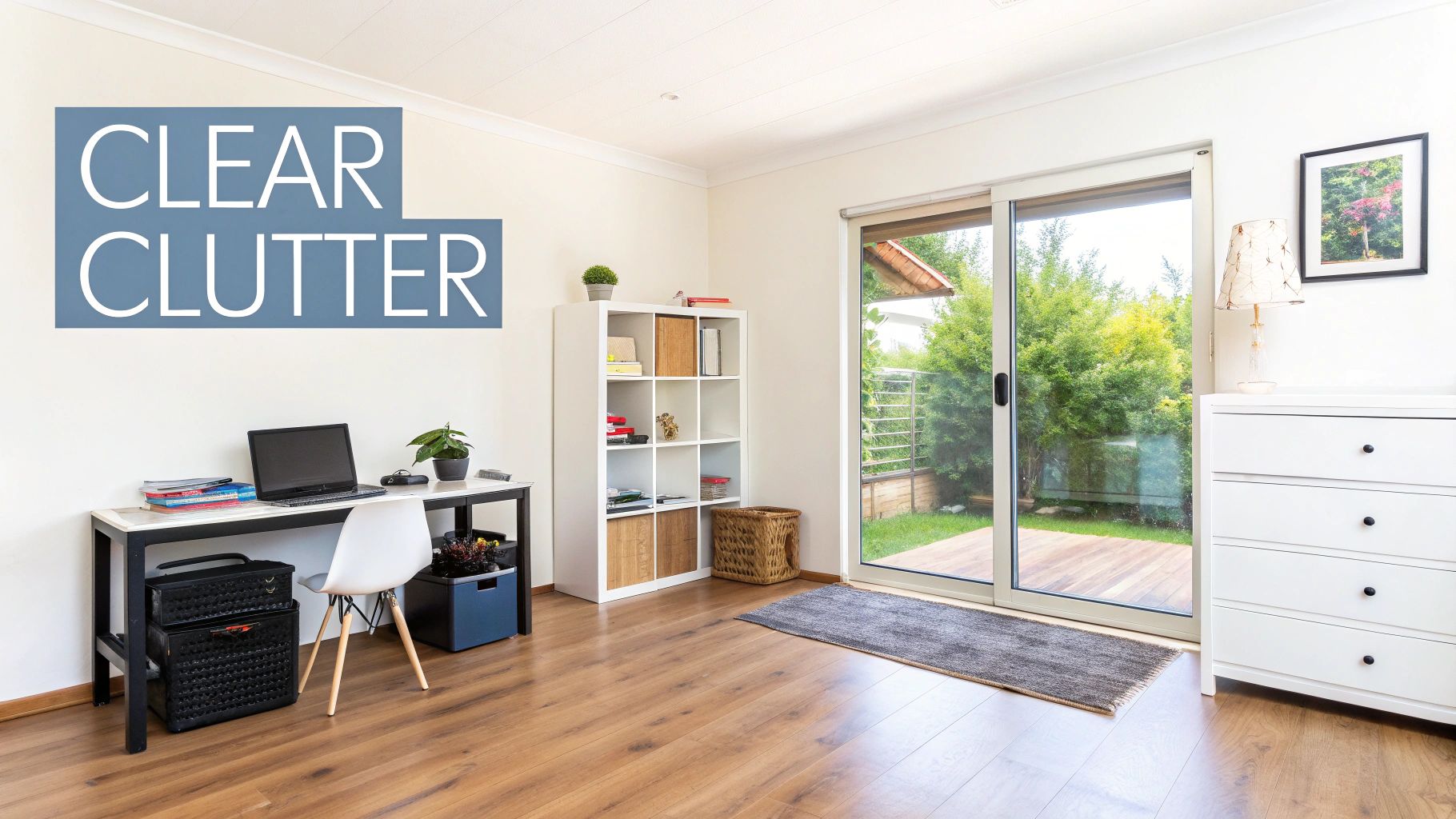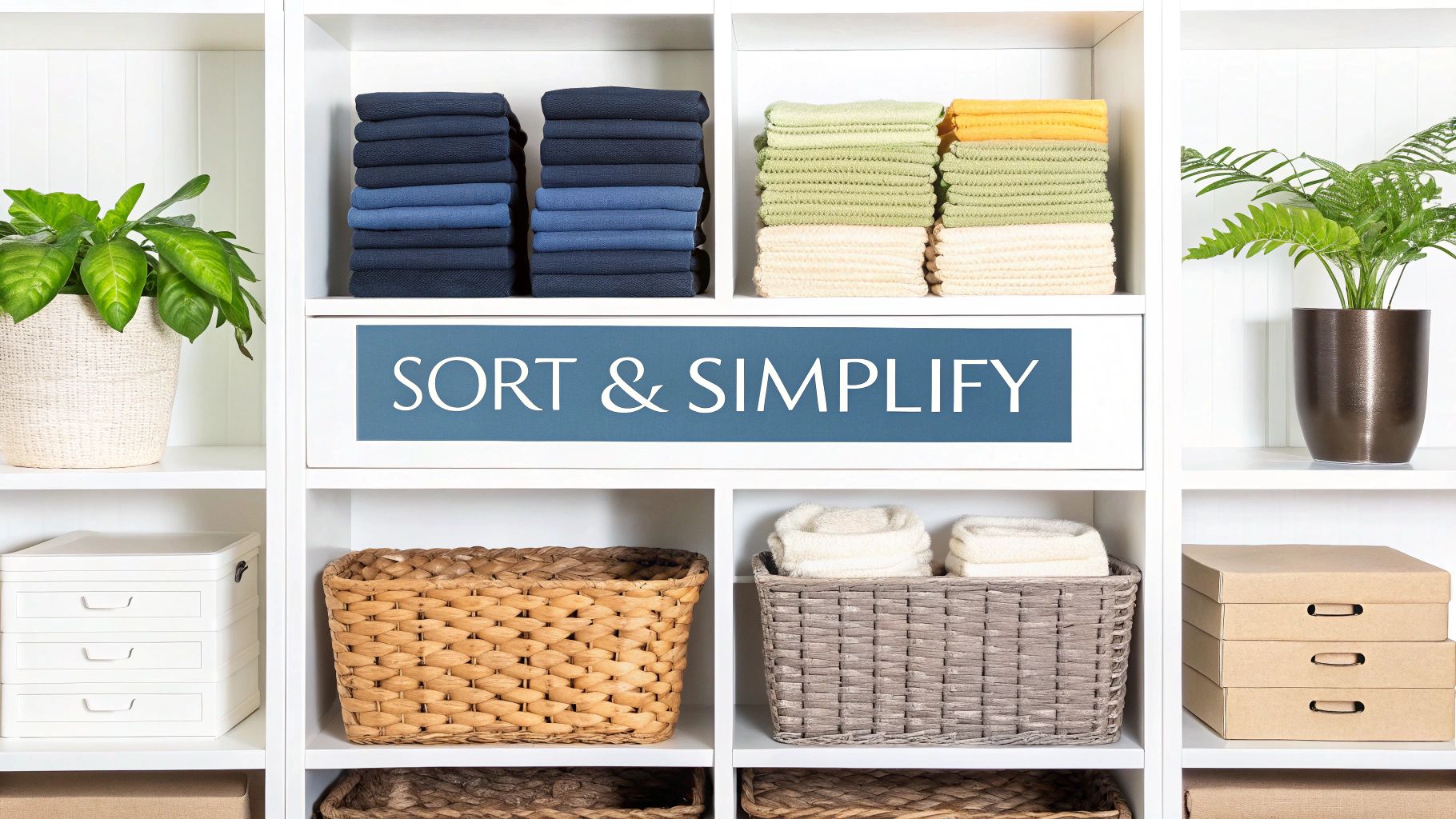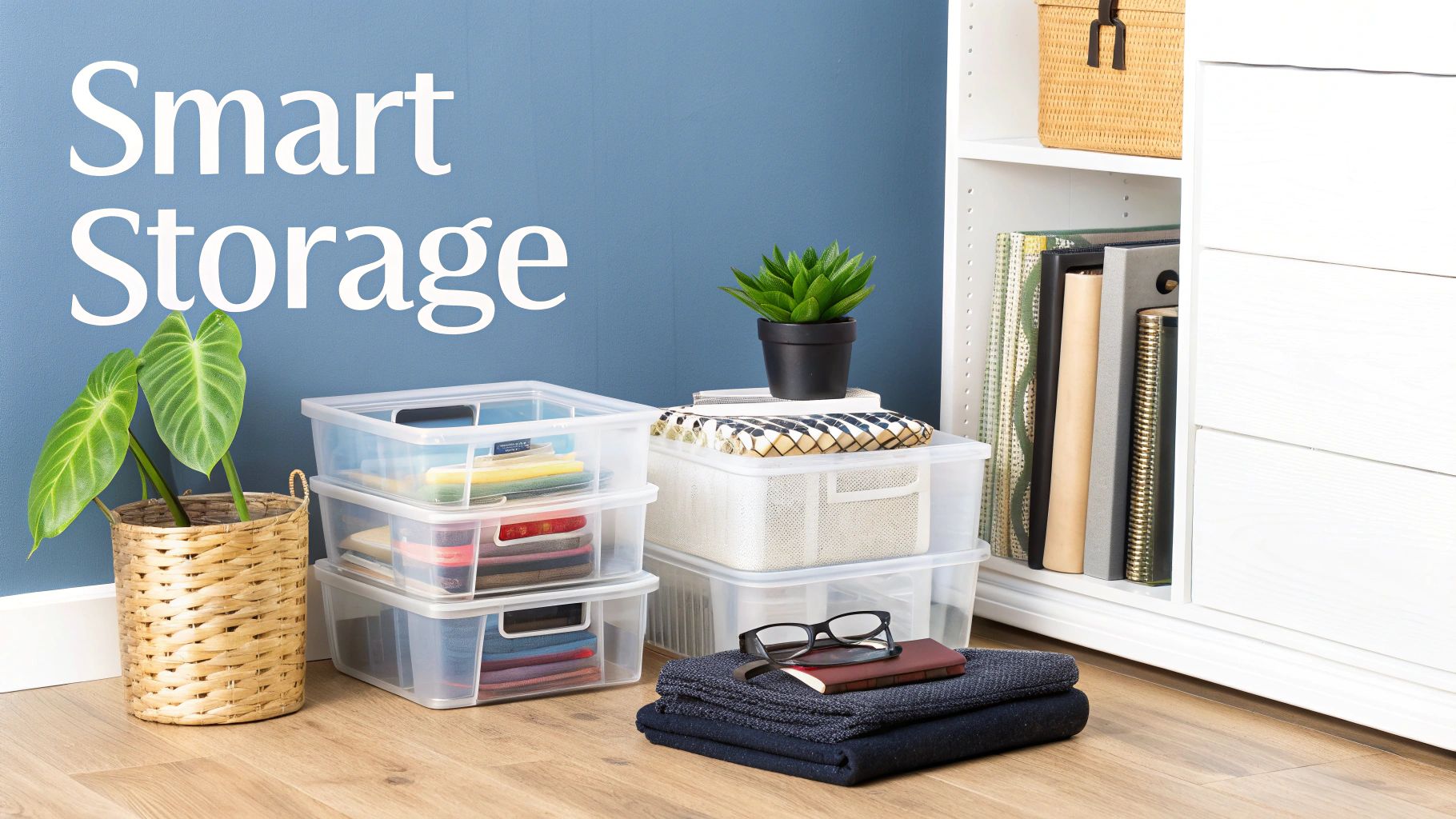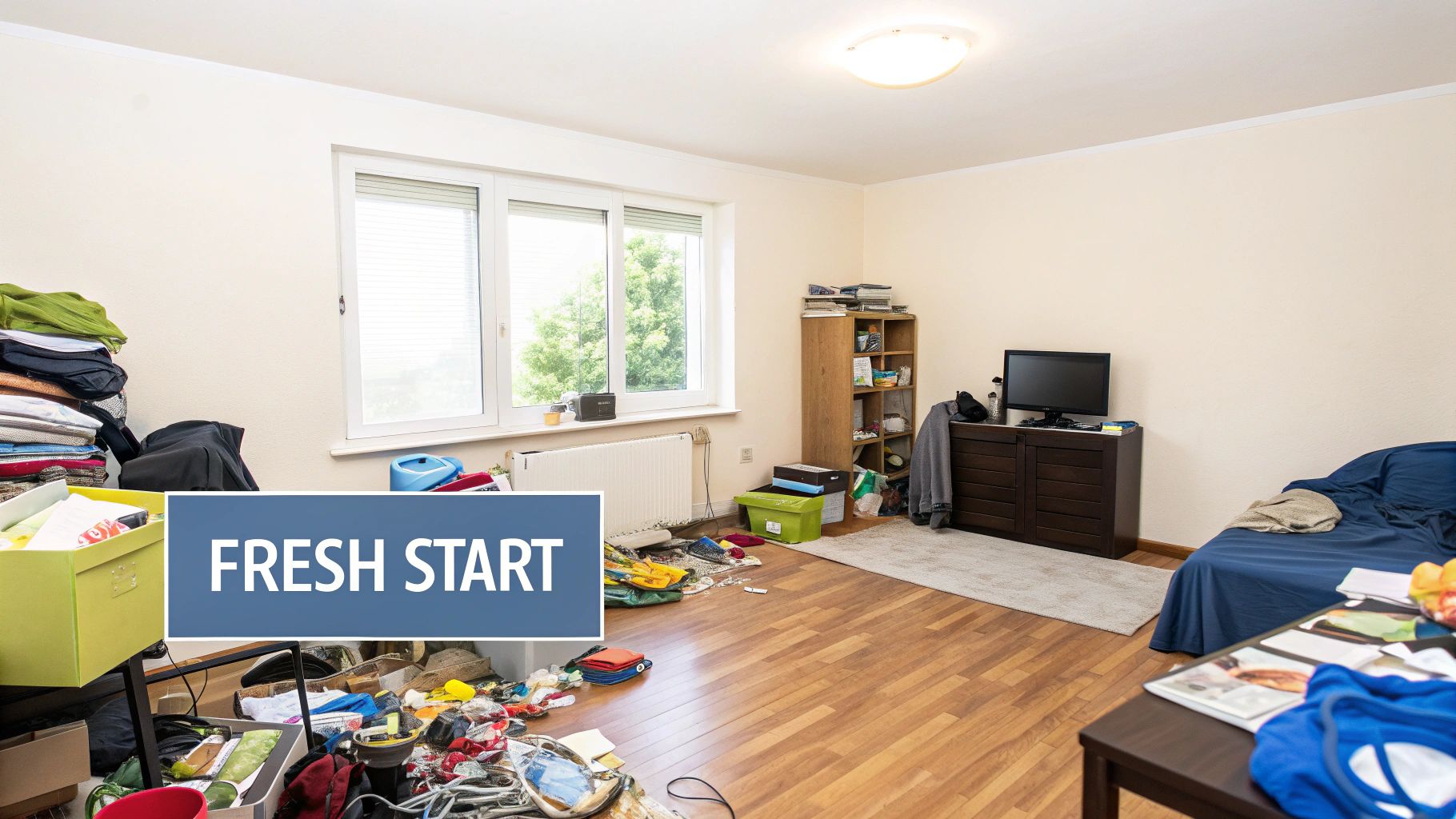The Hidden Impact of Clutter on Your Wellbeing
Beyond simply looking messy, clutter has a significant impact on our daily lives. It’s more than just an eyesore; it can deeply affect our mental and emotional wellbeing. This isn’t just a casual observation; research shows a strong link between cluttered environments and heightened stress. A cluttered room can overstimulate your brain, making it challenging to truly relax and recharge.

The Science Behind the Stress
Clutter bombards our senses, creating a feeling of being overwhelmed. Our brains constantly process the excessive visual input, making it harder to focus on individual tasks. Imagine trying to work in a room overflowing with papers, clothes, and miscellaneous items.
Your eyes dart around, taking in all the “stuff,” diverting your attention from what you’re trying to accomplish. This overstimulation triggers the release of stress hormones like cortisol, contributing to feelings of anxiety and frustration.
From Physical Clutter to Mental Fog
This constant sensory overload can also hinder cognitive function, leading to what experts refer to as mental clutter. You might find it harder to make decisions, recall important information, or think clearly. It’s like having countless tabs open in a web browser – everything slows down.
A cluttered space can also evoke feelings of embarrassment or shame, particularly when unexpected guests arrive. This adds another layer of emotional stress to an already overwhelmed mind. You might find some helpful tips in this article: How to master organization.
The Domino Effect of Disorganization
The effects of clutter extend beyond stress and mental fog. It can negatively impact productivity, sleep quality, and even personal relationships. A disorganized home can make finding things a real challenge, wasting time and increasing frustration.
This, in turn, can decrease productivity both at work and at home. The stress caused by clutter can also disrupt sleep, leading to fatigue and irritability. The average American throws away approximately 81 pounds of clothing each year. Furthermore, it’s estimated that we never use roughly 80-90% of the items we keep in our homes. This not only highlights significant waste but also contributes to environmental problems. The connection between clutter and stress is undeniable, with more than 80% of people reporting feelings of anxiety due to disorganized living spaces. You can explore more statistics on clutter here. Decluttering, therefore, isn’t just about aesthetics; it’s about cultivating an environment that supports overall wellbeing. Recognizing the hidden impact of clutter is the first step towards a more organized and fulfilling life.
Setting the Stage for Decluttering Success

Before you even pick up a single item, remember that preparation is key to successful decluttering and organizing. Think of it like a recipe: the right ingredients and prep work are essential for a delicious outcome. A well-defined plan sets the stage for a smoother, less stressful, and ultimately, more rewarding decluttering experience.
Creating a Personalized Action Plan
Start by creating a personalized action plan. Consider your lifestyle, the time you have available, and the specific areas you want to tackle. Breaking down the task of decluttering your entire home into smaller, manageable projects is crucial.
Instead of trying to do everything at once, focus on one room, a single drawer, or even just a shelf. This approach prevents burnout and provides a sense of accomplishment as you go. Set realistic timelines that fit your schedule. Decluttering is a marathon, not a sprint!
Gathering Your Decluttering Toolkit
Next, gather your decluttering tools. You’ll likely need boxes or bags for sorting items into categories like “donate,” “sell,” or “discard.” Having these ready streamlines your decision-making.
Labels, markers, and a notebook can also be helpful for jotting down ideas and tracking your progress. These physical preparations make the actual decluttering process much more efficient. It’s all about laying the groundwork for smooth execution when you begin the physical work.
Addressing the Emotional Aspect
Decluttering isn’t just about physical objects; it’s often emotionally challenging. Many of us develop attachments to our possessions, making it difficult to let go. Acknowledge the emotions that come up during the process.
Reflect on why you’re holding onto certain items and consider the purpose they serve (or no longer serve) in your life. Involve family members in the decision-making process for shared spaces. This collaborative approach helps everyone feel heard and respected, creating a sense of shared responsibility. Interestingly, the home organizing industry is booming. By 2021, the market size reached $11.4 billion and is expected to grow at a 4% annual rate through 2025. This highlights a growing trend of people seeking professional help with home organization. In the US, 54% of Americans feel overwhelmed by clutter, with the average home containing an astounding 300,000 items. Find more statistics here.
Establishing Clear Criteria
Finally, establish clear criteria for your decision-making. Before you start, define what you want to achieve in each space. Are you going for a minimalist aesthetic, improved functionality, or just a less cluttered environment?
Having this clarity helps prevent the dreaded “maybe pile” from growing and derailing your progress. By asking yourself specific questions—like whether an item is useful, beautiful, or sentimentally valuable—you’ll be able to make confident decisions about what to keep and what to let go. Setting these parameters helps maintain momentum and prevents the process from feeling overwhelming. With these preparations in place, you’ll be well-equipped to declutter and organize your home effectively, creating a space that truly supports your well-being.
Transform Every Space: Room-by-Room Strategies

Now that you’ve prepared, let’s explore decluttering and organizing strategies for each room. Every area of your home has different needs and requires a unique plan. A kitchen needs to be functional, while a bedroom should promote relaxation. Understanding these differences is key to successful organization.
The Heart of the Home: Kitchen Strategies
The kitchen is a hub of activity. Start by emptying drawers and cabinets, then group similar items. Donate duplicate utensils or appliances you rarely use. This creates valuable space and makes meal preparation easier. Focus on creating zones for specific tasks—baking, cooking, and storage—to improve your kitchen’s workflow.
Creating a Tranquil Bedroom Sanctuary
Your bedroom should be your personal retreat. Declutter surfaces like nightstands and dressers, removing anything that doesn’t create a sense of calm. This might include work items, stacks of books, or general clutter. Limit decorations to a few meaningful items you truly love. Organizing your closet is also important. Sort clothes by season and donate anything you haven’t worn in a year.
The Living Room: Balancing Form and Function
The living room serves multiple purposes: relaxation and entertaining. Decluttering here involves finding a balance between style and practicality. Remove anything that doesn’t belong, like mail or children’s toys. Then, evaluate your furniture layout. Does it encourage conversation and comfortable relaxation? Finally, organize media and books, discarding duplicates or anything you no longer enjoy.
Bathrooms: Streamlining Your Routine
Bathroom clutter can build up quickly. Discard expired products and medications. Focus on organizing essential toiletries and develop systems for easy access to frequently used items. This might include clear containers and drawer dividers. Use vertical space with over-the-door organizers or wall-mounted shelves.
Home Offices and Children’s Rooms: Taming the Multi-Purpose Zones
These areas often pose unique challenges. In a home office, create zones for work, storage, and supplies. In a child’s room, use age-appropriate organization. Use bins and labels to encourage kids to tidy up. Involving children in the process builds good habits.
Identifying Your Home’s Problem Zones
Every home has areas that attract more clutter. Identify these problem zones and create custom solutions. Do you constantly drop keys and mail on the entryway table? Add a key hook and a mail sorter. Addressing these small issues prevents clutter from building up.
To help prioritize your decluttering efforts, check out this handy guide:
Decluttering Priority Guide by Room: A systematic approach to which rooms to declutter first based on impact and difficulty level
| Room | Difficulty Level | Time Required | Impact on Daily Life | Recommended Approach |
|---|---|---|---|---|
| Kitchen | Medium | 2-4 hours | High | Zone cleaning, discarding expired items, maximizing vertical space |
| Bedroom | Medium | 2-3 hours | High | Decluttering surfaces, organizing closet, creating a calming atmosphere |
| Bathroom | Easy | 1-2 hours | Medium | Discarding expired products, organizing toiletries, utilizing vertical space |
| Living Room | Medium | 2-3 hours | Medium | Removing unnecessary items, optimizing furniture arrangement, organizing media |
| Home Office | Medium-High | 3-5 hours | Medium | Creating designated zones, implementing filing systems |
| Children’s Room | Medium | 2-4 hours | Medium | Implementing age-appropriate organization systems, involving children in the process |
This table helps you visualize which rooms will give you the biggest return on your decluttering investment. Focus on areas with high impact on your daily life first.
Moving Beyond One-Size-Fits-All Approaches
Effective decluttering means moving beyond generic advice and finding solutions that fit your lifestyle. This is more effective than forcing a one-size-fits-all system. By understanding how to declutter each room effectively, you can create a home that is both beautiful and functional.
Creating Organization Systems That Actually Stick

Beautifully organized spaces can quickly become disorganized when aesthetics are prioritized over functionality. It’s similar to buying beautiful shoes that are uncomfortable; they might look great, but you won’t wear them. Effective organization systems are designed around your actual habits and workflows, not an idealized version of them.
This means understanding how you interact with your space and creating systems that complement those behaviors. Learn more in our article about category organization.
Matching Solutions to Personal Workflows
Effective organization is all about personalization. For example, if you habitually drop your keys and mail on the counter upon entering your home, a simple key hook and mail sorter by the entrance can prevent clutter.
Also, consider how frequently you use different items. Frequently used items should be easily accessible, while less frequently used items can be stored out of the way. When organizing a room, innovative sliding door designs can maximize both space and accessibility. This small change can make a significant difference in maintaining organization. This personalized approach is far more effective than trying to impose a generic system that doesn’t suit your lifestyle.
Visual vs. Hidden Storage: A Matter of Personality
Understanding your preference for visual or hidden storage is another key element. Some people prefer visible, neatly displayed items, while others prefer everything tucked away.
If visual clutter is overwhelming, prioritize closed storage solutions like drawers, cabinets, and covered bins. If you enjoy seeing your belongings and find open shelving aesthetically pleasing, embrace that style. The key is to choose what creates a sense of calm and order for you.
Investing in Long-Term Value
Not all organizing products are equal. Some offer lasting value, while others offer only temporary satisfaction. Invest in durable, high-quality storage solutions built to last.
This means choosing strong containers, reliable shelving systems, and well-made drawer dividers. While the initial investment might be slightly higher, these choices save money and frustration in the long run. For instance, investing in matching containers not only looks appealing but also creates a uniform system that is easier to maintain. This uniformity reduces visual clutter and helps maintain a tidy space. Focusing on quality and function ensures your investment contributes to a sustainably organized home. The demand for professional organizers reflects this emphasis on long-term organization solutions. The global market for professional organizers was valued at $11.08 billion in 2023 and is projected to reach $28.46 billion by 2031, growing at a CAGR of 11.61%. More detailed statistics can be found here. This global trend demonstrates the growing awareness of the importance of organization and decluttering for a healthy and efficient lifestyle.
Embracing Organizational Philosophies
Different organizational philosophies can guide your journey toward a more organized and clutter-free home. Minimalism, for example, encourages keeping only essential and valued items, promoting a sense of calm by reducing clutter. Other approaches emphasize categorization methods, grouping similar items for easy retrieval. Experimenting with various strategies helps you find the best fit for your tendencies and lifestyle, creating a system that is both aesthetically pleasing and easy to maintain over time. This foundation helps solidify initial decluttering efforts, transforming your home and life for the better.
Beyond The Trash Bin: Ethical Decluttering Pathways
Decluttering and organizing doesn’t have to mean overflowing landfills. While sometimes discarding items is unavoidable, there are more sustainable and ethical approaches to managing unwanted belongings. This involves shifting our mindset from simply getting rid of things to considering their potential for reuse or repurposing.
Evaluating Items for Appropriate Destinations
The first step is to evaluate each item. Instead of immediately tossing something in the trash, pause and consider these options:
- Donation: Many charities accept clothing, household goods, and even furniture in good condition. Donating gives items a second life and supports those in need.
- Resale: Selling gently used clothing, electronics, or furniture through online marketplaces like eBay or Facebook Marketplace or consignment shops can bring in extra cash while keeping items out of landfills.
- Recycling: For items that can’t be donated or resold, explore recycling options. Many communities have designated drop-off locations for materials like electronics, textiles, and paper.
- Responsible Disposal: As a last resort, dispose of items responsibly according to your local waste management guidelines. This might involve separating hazardous waste or large items for special collection.
Finding Local Resources and Researching Organizations
Finding local resources is crucial for ethical decluttering. Start by researching organizations that align with your values. Some charities specialize in specific areas, such as supporting veterans or providing resources to families in need.
For electronics and textiles, research local recycling centers or initiatives that ensure responsible processing. Check online directories or contact your local municipality for information on disposal facilities and guidelines. You might also be interested in resources like How to master organization by category for further tips.
Balancing Efficiency With Ethical Considerations
While efficient decluttering is important, it’s crucial to balance it with ethical considerations. Taking the time to sort items and research the best disposal methods minimizes your environmental impact and benefits your community.
This approach might take a bit more time and effort initially, but it’s a worthwhile investment in sustainable living. It’s a shift from a mindset of disposability to one of responsibility.
To help guide your decisions, here’s a helpful table:
Item Disposal Guide: A comprehensive reference for how to responsibly dispose of different categories of unwanted items
| Item Category | Donation Options | Selling Platforms | Recycling Methods | Environmental Impact |
|---|---|---|---|---|
| Clothing | Goodwill, Salvation Army, Local Shelters | eBay, Poshmark, ThredUp | Textile Recycling Centers | Reduces textile waste in landfills |
| Electronics | Goodwill (for working electronics), Local Charities | eBay, Facebook Marketplace, Craigslist | Best Buy, Staples (e-waste recycling) | Prevents hazardous materials from entering landfills |
| Furniture | Habitat for Humanity, Furniture Banks | Craigslist, Facebook Marketplace, OfferUp | Check with local waste management for bulky item pickup | Reduces furniture waste and supports reuse |
| Books | Libraries, Schools, Charities | Amazon, eBay, Used Bookstores | Paper Recycling Bins | Conserves resources and reduces paper waste |
| Household Goods | Goodwill, Salvation Army | Local consignment shops, online marketplaces | Check with local recycling centers | Diverts reusable items from landfills |
This table provides a starting point for making responsible choices about your unwanted items. Remember to check with your local organizations for specific guidelines.
Mindful Consumption and Disposal Practices
Finally, involve your household in ethical decluttering to promote a culture of mindful consumption and disposal. Discuss the importance of reducing waste and making conscious purchasing decisions.
By involving family members, you create a shared commitment to responsible disposal. This collaborative approach makes decluttering more manageable and instills valuable habits for a more sustainable lifestyle. This prevents future clutter buildup and keeps your home a haven of order and peace. It transforms decluttering and organizing into a meaningful act of environmental stewardship.
Preserving Order: The Art of Maintenance
Maintaining an organized home isn’t a one-time project, but an ongoing journey. Think of it like tending a thriving garden – consistent care and attention are essential. This means establishing habits and routines to keep clutter at bay, and adjusting your systems as your life evolves.
Daily Habits for a Clutter-Free Home
Small daily habits can make a big difference in maintaining order. Start by making your bed each morning and clearing surfaces like kitchen counters and dining tables after each use. This prevents clutter from building up in these high-traffic zones. Also, set aside a few minutes each evening to tidy common areas, returning items to their designated places. It’s as simple and essential as brushing your teeth.
Weekly Routines for Deeper Organization
Beyond daily habits, weekly routines provide an opportunity for deeper organization. This might involve sorting mail, emptying bins, and decluttering surfaces prone to accumulating items, like entryway tables or desks. This weekly check-in prevents those small piles from transforming into mountains of clutter. A regular laundry routine can also prevent clothes from piling up and contributing to a sense of disarray.
Adapting to Life’s Changes
Life is constantly changing. Moves, changing seasons, and shifts in family dynamics can disrupt even the most organized systems. Moving offers a perfect opportunity to declutter by reassessing belongings and purging unused items. Seasonal changes are a great time to rotate clothing, storing out-of-season items to free up closet space. During significant life changes, like welcoming a new family member or starting a new job, adapt your organization systems to reflect your new needs and priorities.
Implementing Household Rules
Establishing clear household rules can significantly prevent clutter. Consider a “one-in, one-out” rule for certain categories, like clothes or toys. This means for every new item acquired, a similar item is donated or discarded. Remember flexibility is key. Modify rules to suit your family’s dynamics and preferences. Involving family members in the rule-making process fosters shared responsibility and prevents organization from becoming a point of contention.
Realistic Maintenance Schedules and Early Warning Signs
Create a realistic maintenance schedule that fits your lifestyle. This could involve a monthly decluttering session, a quarterly deep clean, or an annual purge of unused items. Consistency is crucial.
Learn to recognize the early warning signs of a system breakdown. Is a specific drawer always overflowing? Is mail piling up? Identifying these problem areas early allows for swift action, preventing minor issues from escalating into major organizational headaches. This proactive approach saves time and effort in the long run. By regularly evaluating your needs, you ensure your organizational system remains a helpful tool, not a constant struggle.
Ready to create a truly organized and clutter-free home? Explore LAMU, the home organizers and storage brand offering practical and stylish solutions. Visit LAMU today to discover their product range and simplify your life.








Leave a comment